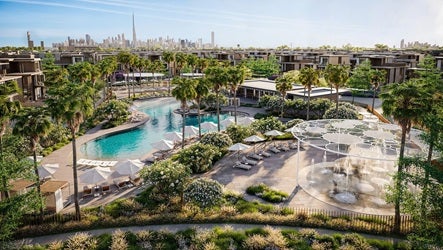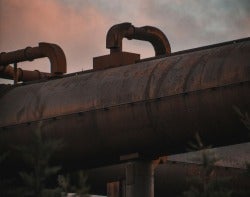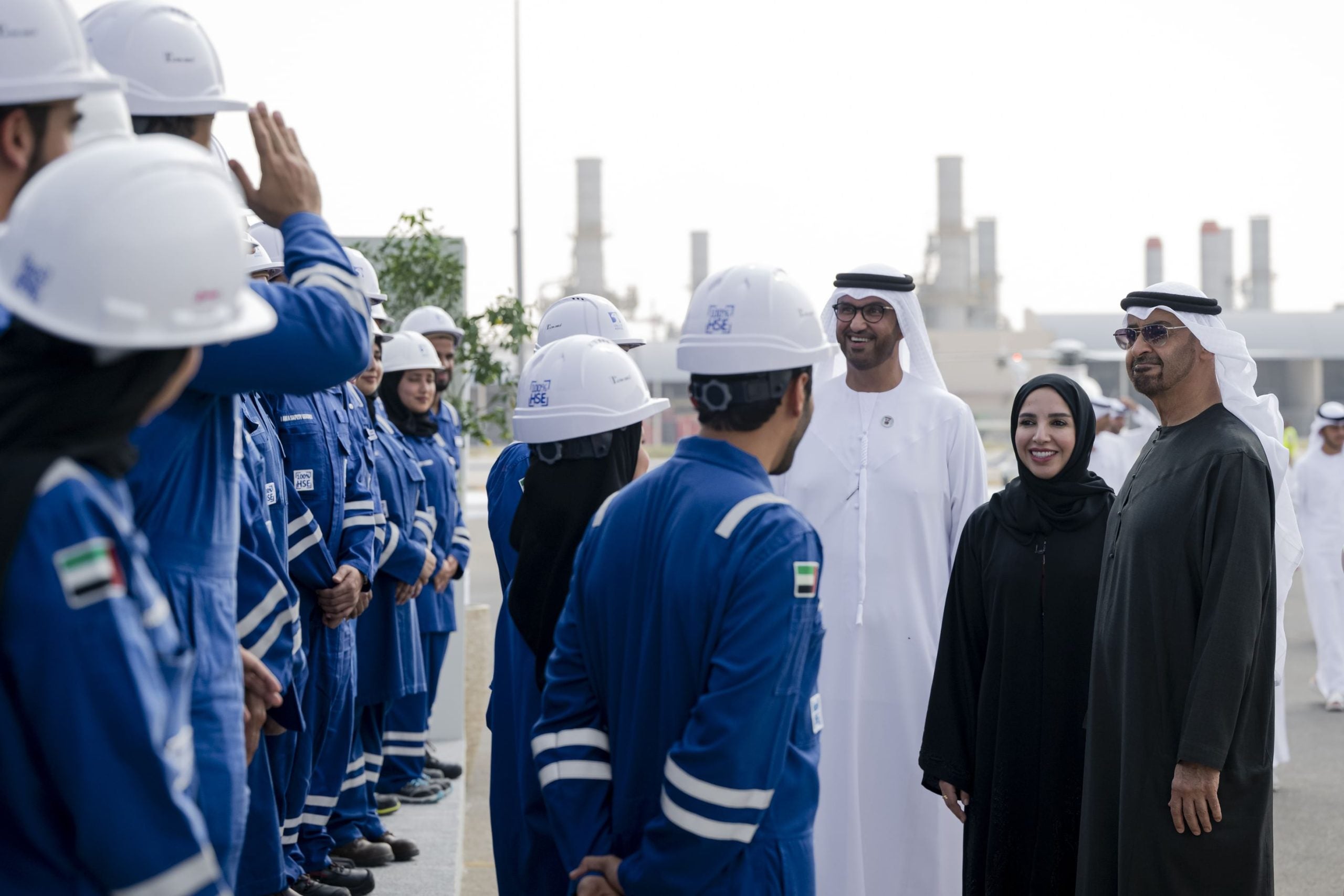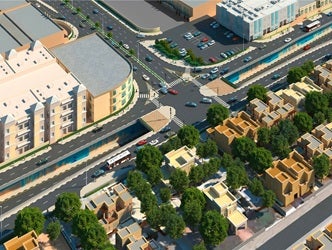SWPC focuses on desalination and sewage plants
30 September 2024

The latest seven-year statement of Saudi Water Partnership Company (SWPC), the kingdom’s main water offtaker, has significantly fewer projects compared to the previous statement covering the years 2022-28.
MEED understands the streamlined projects pipeline is due in part to SWPC now splitting the responsibility to procure water transmission pipeline and reservoir projects in particular with the Water Transmission & Technologies Company (WTTCO), and Saudi Water Authority (SWA) having resumed the tendering of major water desalination projects.
Ouf of 50 projects in five sub-sectors in the previous capacity procurement plan, the latest statement specifies over a dozen future projects, in addition to about six that are in the tendering process and several others that were awarded during the intervening period.
Of the four or five sub-sectors, the independent water projects (IWPs) appear less susceptible to the changes, with SWPC’s Seven-Year Statement covering the years 2024-30 indicating procurement plans for seven IWPs, consistent with the previous statement’s capacity procurement plan.
These schemes have a total combined capacity of about 2.75 million cubic metres a day (cm/d) and are expected to reach commercial operations between 2028 and 2032.
This is in addition to two projects in the bid evaluation stage: the 300,000 cm/d Ras Mohaisen IWP and the 600,000 cm/d Jubail 4 and 6 projects.
“Our goal is to achieve 100% private-sector participation in the production of desalinated water by 2030,” the statement quoted Khaled AlQureshi, SWPC chief executive, as saying.
A similar number of independent sewage treatment plant (ISTP) projects – seven in total – are included in SWPC’s latest seven-year statement, which is down by six compared to the previous plan, and inclusive of the Al-Haer ISTP project, which has since been awarded.
The total planned treated sewage capacity is about 370,000 cm/d, exclusive of the yet-to-be-announced capacity for the Arar ISTP project. These sewage treatment plants are expected to come online between 2027 and 2029.
A plan to procure small sewage treatment plants remains, but the latest SWPC Seven-Year Statement is silent on which of the planned seven clusters it will implement or procure.
The latest statement is equally silent on future independent water transmission pipeline (IWTP) projects, apart from the one that is under construction and two that are in the bidding stage.
The $2bn Rayis-Rabigh IWTP is under construction, bid evaluation is under way for the Jubail-Buraydah IWTP, while SWPC expects to receive bids in February next year for the Riyadh-Qassim IWTP project.
From a pipeline of 14 independent strategic water reservoir (ISWR) projects two years earlier, inclusive of the under-construction Juranah ISWR, the Seven-Year Statement mentions only three future IWTP projects, including one in Al-Ahsa, which has a capacity of 1.39 million cubic metres, and the Dammam ISWR with a capacity of 3.13 million cubic metres.
According to an industry expert, the drive to improve energy efficiency, reuse treated water and improve storage capacity, while keeping up with increasing demand, implies that the kingdom needs to tap both public-private partnerships (PPPs) and engineering, procurement and construction (EPC) models for additional water capacity in the future.
Sharing responsibilities
MEED reported in March that the responsibility for procuring several water transmission pipeline projects in Saudi Arabia had been transferred from SWPC to WTTCO, a spin-off of the Saline Water Conversion Company, which is now called SWA.
Formed in 2019, WTTCO is responsible for "managing, operating and maintaining water transmission, storage and dispatch systems across the kingdom".
It was reported that the procurement model for the following water transmission pipeline projects has also shifted from build-operate-transfer to EPC:
- Jizan-Al Shuqaiq
- Tabuk-Ula
- Rabigh-Jeddah
- Ras Al Kahir-Hafar
IWP and ISTP focus
SWPC announced in May the start of the prequalification process for companies keen to participate in developing five desalination IWPs and seven ISTP projects in the kingdom.
Developers and investors expressed interest in bidding for the projects last July. SWPC also requested that companies submit separate expressions of interest for the IWPs and ISTP projects.
The programme "will provide local and international developers the opportunity to obtain prequalification approval and receive the request for proposal documents for its future projects ... without the need to submit a separate qualification application for each project".
The five IWPs have a total combined capacity of 1.7 million cm/d. The seven ISTP projects have a total combined capacity of 700,000 cm/d.
The tenders for these projects are expected to launch between 2024 and 2026.
In June, MEED reported that SWPC is in the process of appointing a transaction advisory team for this batch of IWP and ISTP projects.
Restructuring
The kingdom's water sector has been undergoing a restructuring programme, with the capacity procurement process linked to the 2030 National Water Strategy being undertaken by three other clients: SWA, WTTCO and the National Water Company.
SWA, for its part, has received bids in the past few months for EPC contracts for four reverse osmosis technology-based water desalination plants, which have a total combined capacity of about 2 million cm/d. The contract to design and build one of the four projects, the 300,000 cm/d Yanbu seawater reverse osmosis plant, was awarded earlier in September.
Exclusive from Meed
-
 Visa agrees to support digital payments in Syria
Visa agrees to support digital payments in Syria5 December 2025
-
 Meraas announces next phase of Nad Al-Sheba Gardens
Meraas announces next phase of Nad Al-Sheba Gardens5 December 2025
-
 Frontrunner emerges for Riyadh-Qassim IWTP
Frontrunner emerges for Riyadh-Qassim IWTP5 December 2025
-
 Adnoc creates new company to operate Ghasha concession
Adnoc creates new company to operate Ghasha concession5 December 2025
-
 Dubai RTA announces Al-Wasl road development project
Dubai RTA announces Al-Wasl road development project5 December 2025
All of this is only 1% of what MEED.com has to offer
Subscribe now and unlock all the 153,671 articles on MEED.com
- All the latest news, data, and market intelligence across MENA at your fingerprints
- First-hand updates and inside information on projects, clients and competitors that matter to you
- 20 years' archive of information, data, and news for you to access at your convenience
- Strategize to succeed and minimise risks with timely analysis of current and future market trends

Related Articles
-
 Visa agrees to support digital payments in Syria
Visa agrees to support digital payments in Syria5 December 2025
Visa and the Central Bank of Syria have agreed on a strategic roadmap that will allow the US-based card and digital payments company to begin operations in Syria and support the development of a modern digital payments system.
Under the agreement, Visa will work with licensed Syrian financial institutions under a phased plan to establish a secure foundation for digital payments.
The early stages will involve Visa supporting the central bank in issuing Europay, Mastercard and Visa (EMV)-compliant payment cards and enabling tokenised digital wallets – bringing the country in line with internationally interoperable standards.
Visa will also provide access to its platforms, including near-field communication (NFC) and QR-based payments, invest in local capacity building and support local entrepreneurs seeking to develop solutions leveraging Visa’s global platform.
“A reliable and transparent payment system is the bedrock of economic recovery and a catalyst that builds the confidence required for broader investment to flow into the country,” noted Visa’s senior VP for the Levant, Leila Serhan. “This partnership is about choosing a path where Syria can leapfrog decades of legacy infrastructure development and immediately adopt the secure, open platforms that power modern commerce.”
The move marks one of the most significant steps yet in Syria’s slow and uneven return to the formal global financial system and carries implications that reach beyond just payments technology.
It lays the groundwork for overturning more than a decade of financial isolation in which Syria has operated largely outside global banking and settlement networks.
Visa’s entry will not erase all existing barriers – as many restrictions remain in force and will continue to shape what is practically possible – but its support signals a reopening of channels that could smooth Syria’s reintegration into financial networks.
The involvement of the US-based payments provider is also a further tacit sign of the US government’s enthusiastic bear hug of the new post-Assad Syrian government under President Ahmed Al-Sharaa.
For investors assessing long-term opportunities, the presence of a globally recognised payments operator will provide reassurance that Syria’s financial system is returning to international norms, and the security and transparency that comes with it.
https://image.digitalinsightresearch.in/uploads/NewsArticle/15207198/main.gif -
 Meraas announces next phase of Nad Al-Sheba Gardens
Meraas announces next phase of Nad Al-Sheba Gardens5 December 2025
Dubai-based real estate developer Meraas Holding, which is part of Dubai Holding, has announced the eleventh and final phase of its Nad Al-Sheba Gardens residential community in Dubai.
It includes the development of 210 new villas and townhouses and a school, which will be located at the northwest corner of the development.
The latest announcement follows Meraas awarding a AED690m ($188m) contract for the construction of the fourth phase of the Nad Al-Sheba Gardens community in May, as MEED reported.
The contract was awarded to local firm Bhatia General Contracting.
The scope of the contract covers the construction of 92 townhouses, 96 villas and two pool houses.
The contract award came after Dubai-based investment company Shamal Holding awarded an estimated AED80m ($21m) contract to UK-based McLaren Construction last year for the Nad Al-Sheba Gardens mall.
The project covers the construction and interior fit-out of a two-storey mall, covering an area of approximately 12,600 square metres.
The UAE’s heightened real estate activity is in line with UK analytics firm GlobalData’s forecast that the construction industry in the country will register annual growth of 3.9% in 2025-27, supported by investments in infrastructure, renewable energy, oil and gas, housing, industrial and tourism projects.
The residential construction sector is expected to record an annual average growth rate of 2.7% in 2025-28, supported by private investments in the residential housing sector, along with government initiatives to meet rising housing demand.
https://image.digitalinsightresearch.in/uploads/NewsArticle/15206904/main.jpg -
 Frontrunner emerges for Riyadh-Qassim IWTP
Frontrunner emerges for Riyadh-Qassim IWTP5 December 2025

Saudi Arabia’s Vision Invest has emerged as frontrunner for the contract to develop the Riyadh-Qassim independent water transmission pipeline (IWTP) project, according to sources.
State water offtaker Saudi Water Partnership Company (SWPC) is preparing to award the contract for the IWTP "in the coming weeks", the sources told MEED.
The project, valued at about $2bn, will have a transmission capacity of 685,000 cubic metres a day. It will include a pipeline length of 859 kilometres (km) and a total storage capacity of 1.59 million cubic metres.
In September, MEED reported that bids had been submitted by two consortiums and one individual company.
The first consortium comprises Saudi firms Al-Jomaih Energy & Water, Al-Khorayef Water & Power Technologies, AlBawani Capital and Buhur for Investment Company.
The second consortium comprises Bahrain/Saudi Arabia-based Lamar Holding, the UAE's Etihad Water & Electricity (Ewec) and China’s Shaanxi Construction Installation Group.
The third bid was submitted by Saudi Arabia's Vision Invest.
It is understood that financial and technical bids have now been opened and Vision Invest is likely to be awarded the deal.
The Riyadh-based investment and development company made a "very aggressive" offer, one source told MEED.
In November, the firm announced it had sold a 10% stake in Saudi Arabia-based Miahona as part of a strategy to reallocate capital "towards new and diversified investments".
The company did not disclose which projects the capital might be reallocated towards.
As MEED recently reported, Vision Invest is also bidding for two major packages under Dubai's $22bn tunnels programme in a consortium with France's Suez Water Company.
The Riyadh-Qassim transmission project is the third IWTP contract to be tendered by SWPC since 2022.
The first two are the 150km Rayis-Rabigh IWTP, which is under construction, and the 603km Jubail-Buraydah IWTP, the contract for which was awarded to a team of Riyadh-based companies comprising Al-Jomaih Energy & Water, Nesma Group and Buhur for Investment Company.
Like the first two IWTPs, the Riyadh-Qassim IWTP project will be developed using a 35-year build-own-operate-transfer contracting model.
Commercial operations are expected to commence in the first quarter of 2030.
https://image.digitalinsightresearch.in/uploads/NewsArticle/15206609/main.jpg -
 Adnoc creates new company to operate Ghasha concession
Adnoc creates new company to operate Ghasha concession5 December 2025
Register for MEED’s 14-day trial access
The board of directors of Abu Dhabi National Oil Company (Adnoc Group) has approved the establishment of a new company to operate the Ghasha offshore sour gas concession in Abu Dhabi waters.
The decision to create the new entity, to be called Adnoc Ghasha, was taken during a recent meeting of Adnoc Group’s board in Abu Dhabi, which was chaired by Sheikh Mohamed Bin Zayed Al-Nahyan, UAE President and Ruler of Abu Dhabi.
Adnoc Group owns and operates the Ghasha concession, holding the majority 55% stake. The other stakeholders in the asset are Italian energy major Eni with a 25% stake, Thailand’s PTTEP Holding, which holds a 10% interest, and Russia’s Lukoil, owning the remaining 10% stake.
The Ghasha concession consists of the Hail and Ghasha fields, along with the Hair Dalma, Satah al-Razboot (Sarb), Bu Haseer, Nasr, Shuwaihat and Mubarraz fields.
Adnoc expects total gas production from the concession to ramp up to more than 1.8 billion cubic feet a day (cf/d) before the end of the decade, along with 150,000 barrels a day of oil and condensates. This target will mainly be achieved through the Hail and Ghasha sour gas development project.
In October 2023, Adnoc and its partners awarded $16.94bn of engineering, procurement and construction (EPC) contracts for its Hail and Ghasha project – the biggest capital expenditure made by the Abu Dhabi energy company on a single project in its history.
Adnoc awarded the onshore EPC package to Italian contractor Tecnimont, while the offshore EPC package was awarded to a consortium of Abu Dhabi’s NMDC Energy and Italian contractor Saipem.
The $8.2bn contract relates to EPC work on offshore facilities, including facilities on artificial islands and subsea pipelines.
The Hail and Ghasha development will also feature a plant that will capture and purify carbon dioxide (CO2) emissions for sequestration (CCS), in line with Adnoc’s committed investment for a carbon capture capacity of almost 4 million tonnes a year (t/y). The CO2 recovery plant will have a total capacity to capture and store 1.5 million t/y of emissions from the Hail and Ghasha scheme.
Prior to reaching the final investment decision on the Hail and Ghasha project in 2023, the Ghasha concession partners, led by Adnoc, awarded two EPC contracts worth $1.46bn in November 2021 to execute offshore and onshore EPC works on the Dalma gas development project. The project will enable the Dalma field to produce about 340 million cf/d of natural gas.
https://image.digitalinsightresearch.in/uploads/NewsArticle/15206382/main2754.jpg -
 Dubai RTA announces Al-Wasl road development project
Dubai RTA announces Al-Wasl road development project5 December 2025
Register for MEED’s 14-day trial access
Dubai’s Roads & Transport Authority (RTA) has announced the Al-Wasl Road upgrade project, spanning 15 kilometres (km) from the intersection with Umm Suqeim Street to the junction with 2nd December Street.
The scheme includes upgrading six intersections – Al-Thanya, Al-Manara, Umm Al-Sheif, Umm Amara, Al-Orouba and Al-Safa streets – along with upgrading Al-Thanya Street and constructing five tunnels totalling 3.8km.
A new tunnel will be built at the intersection with Al-Manara Street. It will consist of three lanes and split into two routes: two lanes from Sheikh Zayed Road to Jumeirah Street and two lanes from Sheikh Zayed Road to Umm Suqeim Street, with a total capacity of 4,500 vehicles per hour.
The project also includes a 750m-long tunnel on Umm Al-Sheif Street, comprising two lanes from Sheikh Zayed Road to Jumeirah Street, accommodating up to 3,200 vehicles per hour.
A tunnel will be constructed at the intersection of Al-Wasl Road with Umm Amara Street, featuring two lanes in each direction, with a total length of 700m and a combined capacity of 6,400 vehicles per hour.
The road will also be widened from two to three lanes in each direction.
The project is expected to reduce travel times along Al-Wasl Road by 50% and increase capacity from 8,000 to 12,000 vehicles per hour in both directions.
Planning for growth
In March 2021, the government launched the Dubai 2040 Urban Master Plan. Its launch referenced studies indicating that the emirate’s population will reach 5.8 million by 2040, up from 3.3 million in 2020. The daytime population is set to increase from 4.5 million in 2020 to 7.8 million in 2040.
In December 2022, Sheikh Mohammed Bin Rashid Al-Maktoum, Vice President and Prime Minister of the UAE and Ruler of Dubai, approved the 20-Minute City Policy as part of the second phase of the Dubai 2040 Urban Master Plan.
In addition to the road projects, the RTA’s Dubai Metro Blue Line extension forms part of Dubai’s plans to improve residents’ quality of life by cutting journey times, as outlined in the policy.
The policy aims to ensure that residents can meet 80% of their daily requirements within a 20-minute journey time, on foot or by bicycle. This goal will be achieved by developing integrated service centres with all necessary facilities and by increasing population density around mass transit stations.
https://image.digitalinsightresearch.in/uploads/NewsArticle/15205950/main.jpg



